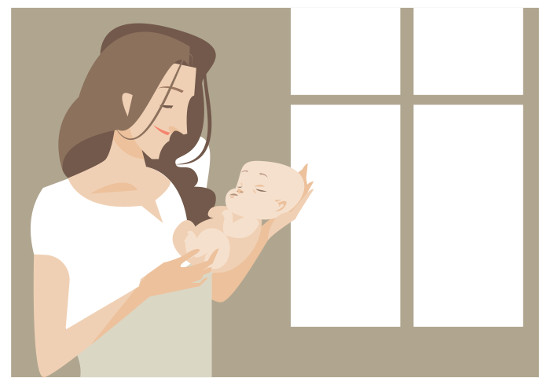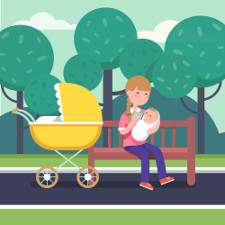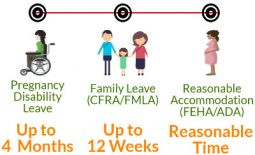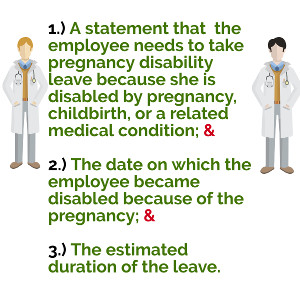
Maternity Leave in California – A Practical Law Guide (2020)
22 Dec 2017
You just found out that you are pregnant. Tense thoughts are racing through your head as you frantically decide how you will grapple with your aggressive employer about taking maternity leave in California.
A feeling of anxiety sinks in as you ponder about the financial burdens that are in store, the backlog of paperwork on your desk, and whether you will even have a job when it is all said and done.
It sounds scary, right? Well, it doesn’t have to be that way. The stress-free secrets to protecting your pregnancy leave rights are only a few scrolls away. And, all you have to do to learn about them for free is to read this guide.
By the end of this article, you are going to learn all about:
- The different maternity laws that provide protections to pregnant mothers;
- The basic rules your company must follow, along with the benefits it must provide; and
- How to maximize the duration of your leave (to spend more time with your child).
Table of Contents:
Which Laws Provide Protection?
Let’s dive in, both California and federal law provide leave rights to working mothers, before, during, and after child birth. Each has its pros and cons. Here is a brief introduction to each law (keep reading below to learn the details):

Pregnancy Disability Leave Law (PDLL or PDL): Provides eligible California employees who are disabled by “pregnancy, childbirth, or a related medical condition” up to four months of unpaid leave. Under the PDLL, it is an illegal employment practice to deny leave to an eligible employee who is disabled by a pregnancy. It is also unlawful for an employer to retaliate against an employee for taking or attempting to take leave under the PDLL. When paired with CFRA, employees can get up to 7 months of leave from work (more on this later).
Family & Medical Leave Act (FMLA): Provides up to twelve weeks of unpaid leave to eligible employees for a serious health condition due to pregnancy, childbirth, or a related medical condition, or to bond with a child after pregnancy. FMLA leave can run concurrently with PDLL at the option of the employer. This means that an employee’s PDLL can count towards the 12 weeks of leave under the FMLA.

California Family Rights Act (CFRA): The CFRA is a California law that provides unpaid medical leave to eligible employees. Interestingly enough, the CFRA does not provide for any pregnancy-related leaves. In fact, the act expressly excludes any coverage for an employee’s disability due to pregnancy, childbirth or a related medical condition. But here is the kicker, it provides up to 12 weeks of leave for baby bonding following the birth of an eligible employee’s child. This leave starts when Pregnancy Disability Leave ends, meaning when the health care provider determines that the mother is no longer disabled and can return to work.

Americans with Disabilities Act (ADA) & California Fair Employment & Housing Act (FEHA): Both the ADA and FEHA provide for a right to a leave of absence as a reasonable accommodation for an employee who has a physical or mental disability as a result of pregnancy, childbirth, related medical condition, or otherwise. This right is both independent and distinct from the right to pregnancy disability leave under the PDLL. Leave under these two laws can serve as a catch-all in the event an employee is not eligible for the ones discussed above. It can also function to extend pregnancy leave as reasonably necessary once pregnancy disability leave and CFRA expire.
California Pregnancy Disability Leave Law
Pregnancy Disability Leave or “PDL” is usually the main go to for pregnant women seeking a maternity leave of absence. It provides powerful safeguards for working mothers, which is why many employers try to stay hush about it. It also offers devastating punishments for companies that violate the law by failing to provide necessary notice, unreasonably delay/deny leave, or retaliate against their employees for taking it.
How Long Is Maternity Leave?

An employer must allow an eligible female employee that is disabled by pregnancy, childbirth, or a related medical condition to take a medical leave of absence for a “reasonable period of time” not to exceed four months. (Govt C §12945(a); 2 Cal Code Regs §11042(a)). Yes, you read that right, and the rule must be followed even if your employer has a leave policy that is less generous for other similarly situated temporarily disabled employees.
It gets better… the four months of leave entitlement for PDL is per pregnancy, not per year. (2 Cal Code Regs §11042(a)(1)). Which means (at least in theory) that an eligible employee would be able to take PDL twice in one year (although very rare). Therefore, PDL is a much more generous deal compared to FMLA which provides only one 12 week leave in any 12-month period.
In practice, an employee may end up entitled to less than four months of actual leave since entitlement is determined by the number of days or hours the employee would regularly work within the four calendar months (more in a bit).
Step 1: Eligibility Requirements:
Not all female employees are eligible for PDL; certain requirement must be met for leave to be available. So let’s take a closer look at the first step involved in asserting maternity leave rights. For the law to apply:
1.) The employer must be covered: The employer must “regularly employ” 5 or more full or part-time employees. (Govt C §12926(d); 2 Cal Code Regs §11035(h)).
Now here is the thing, the number of employees considered “regularly employed” is determined by the number of workers on the payroll, rather than the number working on any certain day. (Robinson v FEHC (1992) 2 C4th 226, 231). Therefore, this requirement can often easily be met unless the employer is tiny.
The State of California is also an “employer” under the law, as well as counties, other political or civil subdivisions of the state and cities, labor organizations, apprenticeships, training programs leading to employment, employment agencies, school district governing boards, and licensing boards. (2 Cal Code Regs §11035(e)). Non- profit religious association and non-profit corporations are exempt.
2.) The employee must be eligible: Only female employees who are disabled by pregnancy, childbirth, or a related medical condition are entitled to PDL. (Govt C §12945(a)). Transgender individuals that are disabled by pregnancy are also eligible. Another nice benefit about pregnancy disability leave is that unlike FMLA/CFRA, there is no required length of time or minimum hours worked before an employee is eligible.
3.) There must be a qualifying reason: The employee must be disabled by pregnancy, childbirth, or a related medical condition. But you may be wondering, “what qualifies as a disability?” Here is the answer:
a. Disability because of an employee’s inability to perform work: A healthcare provider must find that a female employee is (1) unable to perform one or more of the essential functions of her job, or (2) is unable to perform those functions without undue risk to herself, or to the successful completion of her pregnancy, or to other persons (i.e. female employee operating dangerous machinery in a factory). (2 Cal Code Regs §11035(f)).
b. Disability because of an employee’s health needs: An employee is considered disabled by pregnancy if her healthcare provider is of the opinion that she is suffering from “severe morning sickness,” or “any medically recognized physical or mental condition related to pregnancy, childbirth, or recovery from pregnancy or childbirth,” or if the employee needs to take time off for any of the following reasons: (2 Cal Code Regs §11035(f)):
- Prenatal or postnatal care;
- Bed rest;
- Pre-eclampsia;
- Childbirth;
- Postpartum Depression;
- Loss or end of pregnancy; or
- Recovery from childbirth
Step 2: Giving Timely Notice to Your Employer:
It is the responsibility of every employee to provide timely oral or written notice such that the employer can be made aware that the employee needs to take pregnancy disability leave. This includes (when practicable) providing the employer with the estimated duration and timing of the leave. (2 Cal Code Regs §11050(a)(1)).
When the need for the leave is foreseeable, then an employee must give at least thirty days’ notice before the commencement of the leave. The employee must also coordinate with the employer and make a reasonable effort to schedule planned appointments and medical treatments so that disruptions to the employer’s business operations are minimized.
But when the advance thirty days’ notice is not practicable (i.e., when there is a medical emergency), notice must be given to the employer “as soon as practicable.” (2 Cal Code Regs §11050(a)(3)). The employer may not deny the leave in this scenario just on the basis that there wasn’t adequate notice.
Now there is one more point I need to make… If you fail to provide the timely notice when your need for leave is “foreseeable,” then your employer may delay your request for a transfer or reasonable accommodation until thirty days after you provide your employer with the notice. No delay is ever permitted, however, if it would endanger your health or pregnancy, or the health of your co-workers. ((2 Cal Code Regs §11050(a)(6)).
Warning: provide the notice in writing by either email or certified mail. Make sure that there is confirmation of their receipt, that way they cannot later deny that you provided them the notice.
Step 3: Your Employer Provides a Response:
Once notice is received the employer must respond “as soon as practicable” but in no event longer than ten calendar days after the receipt of the request. Furthermore, the employer must try to respond before the leave is set to begin. If the approval is given after the leave commences by the employee, it is deemed retroactive to the first day of leave. (2 Cal Code Regs §11050(a)(5)).
Step 4: You Provide Medical Certification
The employer may require written medical certification from a healthcare provider as a condition of granting leave. However, if the employer does require medical certification, it must request it when the employee gives notice of her need for the leave or within two business days after.
If the need for the leave is unforeseeable, then the employer must request the medical certification within two days after the leave begins. If the employer failed to ask for certification, it could nevertheless request it at a later date if there is a reason to question the appropriateness of the leave or the duration.
The employer must alert the employee of the following (2 Cal Code Regs §11050(b)(1)):
- The requirement that the employee provide medical certification;
- The deadline for delivering it;
- What is considered sufficient certification;
- The consequences if certification is not provided.
An employer required medical certification form must also be provided to the employee for the health care provider to fill out. If the employee is already out on leave because it was unforeseeable, notice of the requirement of medical certification can be delivered orally, after which the employer must send the employee the required certification form by mail, electronic mail, or fax (2 Cal Code Regs §11050(b)(1)).
Required Contents of the Certification:
To be deemed valid the certification must state at least the following:
There is no magic language needed, as long as the information above is provided the employer may not ask for additional information and must accept it as sufficient. However, when the leave period requested by the health care provider expires, the employer may request re-certification if extra time is asked for. (2 Cal Code Regs §11050(b)(8).)
How Much Time Do I Have to Produce the Certification?
If the need for the leave was foreseeable and the employee provided the required thirty-day notice, then the medical certification must be submitted before the leave begins.
If the need was unforeseeable, the employee must provide the certification within the deadline requested by the employer (must be at least 15 days from the date of the request), unless doing so would be unpractical under the particular circumstances despite the employee’s diligent, good faith efforts. (2 Cal Code Regs §11050(c)(2)).
What If the Certification Is Incomplete?
If the certification is inadequate or otherwise incomplete, the employer must notify the employee and provide her with a reasonable opportunity to fix any defects. (2 Cal Code Regs §11050(c)(4)).
What Kind of “Healthcare Providers” Can Certify Me?
The California Code of Regulations provides that only certain health care providers are qualified to determine if an individual is disabled for purposes of PDL. Therefore, you can’t just see a doctor trained in Chinese medicine. You will see that the standard is broad. Here is the list of the healthcare providers that you can get certification from (2 Cal Code Regs §11035(n)):
- An osteopathic or medical doctor, physician, or surgeon, licensed in California, or in another state or country, who directly treats, or supervises the treatment of the employee’s pregnancy, childbirth, or a related medical condition;
- A California licensed (or another state or country) marriage and family therapist or acupuncturist;
- Any other persons who can meet the Federal Family and Medical Leave Act definition of “others capable of providing health care services.” This includes nurse midwives, licensed midwives, nurse practitioners, clinical social workers, chiropractors, clinical psychologists, physician assistants; who “directly treat or supervise the treatment of the employee’s pregnancy, childbirth, or a related medical condition”; or
- A health care provider from whom an employer or a group health plan’s benefits manager will accept the medical certification of the existence of a health condition to substantiate a claim for benefits.
Is My Employer Required to Give Me Notice of My PDL Rights?
This all might seem a bit confusing to you. So here is some good news: your employer must provide you notice of your leave rights! In California, an employer must give its workers reasonable advanced notice of their right to Pregnancy Disability Leave. At a minimum, notice must contain information about (2 Cal Code Regs §11049(b)):
- Your right as an employee to request a reasonable accommodation, transfer, or pregnancy disability leave;
- Your obligation to provide adequate notice in advance of your need for reasonable accommodation, transfer, or pregnancy disability leave;
- The requirement (at the option of the employer) that you provide medical certification.
The notice must be: (1) posted in conspicuous places on the premises, (2) provided to you in writing “as soon as practicable” after you tell your employer that you are pregnant and even sooner if you ask about pregnancy disability leave, transfer, or an accommodation, and (3) provided in the employee handbook (if it has one). (2 Cal Code Regs §11049(d)(3))
By now you’ll be wondering what the consequences are if your company doesn’t provide you with notice. It’s simple: your employer is barred from taking any adverse employment action against you for not providing any notice!
How Do I Calculate the Length of Leave I’m Entitled to?
You can’t just sit back and expect the Human Resources Department of your company to handle your leave without any hiccups. HR associates are often clueless about the law, which means you should expect to crosscheck their work to ensure you obtain the maximum amount of leave hours possible, and that they haven’t screwed up.
We mentioned earlier that an eligible pregnant employee can take up to four months of PDL. But in practice the actual leave amount is usually much less. Why? Because it is based on the number of days or hours that the particular employee would have normally worked within the 4-calendar month period following the start of the leave.

Here is an example: Sally, normally works forty hours a week for a large construction company. Assuming that her doctor certified her as being disabled, she would be entitled to six hundred ninety-three hours of pregnancy disability leave. Why? Because, 17 & 1/3 weeks (4 months) x 40 hours=693 total leave hours.
A second example: Michelle works thirty hours a week in a warehouse. Her OBGYN certifies her as being disabled due to her pregnancy with a four-month anticipated duration. She is entitled to 520 hours 17 & 1/3 weeks (4 months) x 40 hours=520 leave hours.
For employees whose hours vary month to month, entitlement is instead based on the monthly average of the four months before the leave beginning. (2 Cal Code Regs §11035(l)).
Can I Take Intermittent or Reduced Schedule Leave?
Yes, PDL allows for intermittent or reduced schedule leave. An example of intermittent leave would be taking time off for a regularly scheduled or as needed doctor’s appointment due to morning sickness or some other complication. (2 Cal Code Regs §11042(a)(2)(B)).
An employer must account for intermittent leave using increments that are no longer than the shortest period of time their payroll system uses to account for other leaves. This amount of time cannot be any longer than one hour. (2 Cal Code Regs §11042(a)(2)(B)).
If a medical provider certifies the need for intermittent or reduced-schedule leave, then the employer has the option to temporarily transfer the employee to an alternative position that better accommodates her.
The employee must have equivalent pay and benefits but must be qualified for the position. (2 Cal Code Regs §11041(c)). Once the employee’s medical provider certifies that there is no further need for leave, the employer must reinstate the employee to her same position or one that is comparable. (2 Cal Code Regs §11041(d)).
How Do Holidays and Temporary Closures Factor Into Calculations?
Holidays:
A holiday’s impact on the calculation of pregnancy disability leave entitlement depends whether the leave is being taken as a continuous block or if it is intermittent.

In the case of continuous leave, a holiday that falls within a week which is taken as leave does not have any impact on the calculation. Here is a quick example: Brittany typically works a thirty-hour workweek. She takes leave during a week that contains two days of holidays. The entire week still counts as 30 hours against her leave entitlement. (2 Cal Code Regs §11042(a)(2)(C).)
On the other hand, intermittent leave that falls on a holiday does not count towards leave entitlement. Another example: Bridget takes 3 hours of leave every Thursday for a regularly scheduled doctor’s appointment. She attends the doctor’s appointment on a Thursday in which the office is closed because of a Holiday. Her attendance does not count towards her leave entitlement, so she still has 3 hours left in the bank.
Temporary Closures:
If your employer closes temporarily and you are not expected to show up to work for one or more weeks, then the amount of time your employer is closed does not count against your pregnancy disability leave. (2 Cal Code Regs §11042(a)(2)(C)). An example of this might be a hospital closing down for a month for remodeling, or a school is closed during the summer months.
IS PDL Maternity Leave Paid or Unpaid?
Leave taken under the PDLL is unpaid. There is an exception to this (pretty rare), and that is if an employer pays for other similarly situated employees to take temporary disability leave. But get this: female employees may be entitled to receive state disability insurance (called “SDI” or paid family leave “PFL”). For more information for applying for state disability insurance go here. (2 Cal Code Regs §11044(a)).
Can My Employer Force Me to Use Accrued Paid Sick Leave?
Yes, an employer can require that an employee use accrued paid sick leave during pregnancy disability leave. Even if the employer doesn’t require this, it may be a good idea for an employee to opt to use her accrued paid sick leave since PDL is unpaid. 2 Cal Code Regs §11044(b)(1).
Can They require That I Use My Accrued Vacation or PTO?
No, an employer cannot force a pregnant female worker to use accrued vacation time or paid time off during pregnancy leave. (2 Cal Code Regs §11044(b)(2)). However, it may be a good idea to use vacation time or PTO for the reasons discussed above.
Does My Employer Have to Continue to Pay for My Health Insurance?
An employer must continue to pay for group health insurance for employees that are on pregnancy disability leave for up to four months over a twelve-month period per pregnancy. The payments must begin on the first day of the leave, at the same amount, and under the same conditions as before the leave. (2 Cal Code Regs §11044(c)(1)). The employee may at her discretion elect to maintain and pay for the coverage beyond the four months.
Cannot Be Credited Against CFRA

Entitlement to group health insurance under the PDLL is entirely separate and distinct from the CFRA (discussed below). What this means is that your employer cannot credit the health insurance payments made during PDL towards the twelve weeks of health insurance coverage it is obligated to pay for under the CFRA. (2 Cal Code Regs §11044(c)(2); see 2 Cal Code Regs §11046(a)).
Your employer cannot double dip, meaning your employer may be obligated to pay for four months of health insurance coverage under PDLL, and then another 12 weeks under the CFRA.
Can My Employer Recover Premiums from Me?
An employer can recover the insurance premiums paid on behalf of an employee on PDL if (2 Cal Code Regs §11044(c)(3)):
(1.) The employee fails to return from the PDL; and
(2.) The failure to return is because of a reason other than one referenced below:
- The employee is on CFRA leave unless she later decides not to return to work after the CFRA leave;
- The continuation, recurrence, or onset of a health condition that entitles the employee to PDL, unless the employee chooses not to return to work following the leave;
- Non-pregnancy-related medical conditions that require further leave, unless the employee chooses not to return to work following the leave; or
- Any other circumstance beyond the employee’s control (i.e., the employer failed to reinstate the employee correctly, or a baby was born with a serious health condition).
Must my employer maintain my other benefits, as well as my seniority?
Employees on PDL must continue to participate in any employee benefit plan at the same level and under the same conditions as employees taking other forms unpaid disability leave.
If the employer’s policies for any kind of paid or unpaid leave permit seniority to accrue then seniority must also accrue for employees on any form of unpaid or paid pregnancy disability leave. Under no circumstances can a female employee return with less seniority then when the leave began. (2 Cal Code Regs §11044(d)).
Employees must retain their status while on PDL. When employees are reinstated, their benefits must resume in the same manner and at the same levels that were provided when their leave began. No conditions, qualification periods, physical exams, or other qualifications should apply. (2 Cal Code Regs §11044(e)).
Right to Reinstatement
So here’s the deal: leave laws are ultimately useless if workers do not have the right to be reinstated. Fortunately, PDLL provides female employees returning from pregnancy disability the right to return to the same or comparable position at their job.
Tip: Under 2 Cal Code Regs §11043(a), you may request a guarantee in writing confirming that you will be reinstated to the same or comparable position. Refusal by your employer to honor the guarantee is a violation of the law.
How do you establish a violation?

a. When There Is Agreed Upon Return Date:
If an agreement existed on a return date before the leave commenced, the employee establishes an unlawful refusal to reinstate if the employee proves beyond a preponderance of evidence (51% certainty or more) that the employer failed to reinstate the employee to the same or comparable position by the agreed-upon date. (2 Cal Code Regs §11043(b)(1).)
b. When There is a New or Unknown Return Date:
If the agreed-upon return date changed, or if a specific return date was never agreed to, then the employer must reinstate the employee within two days of the employee notifying the employer of her intention to return to work. If there is a business reason (or otherwise) why the two-day deadline is not feasible, then the employer must reinstate as soon as possible. (2 Cal Code Regs §11043(b)(2))
What happens if I am laid off while on leave?
If an employee is laid off during PDL for a “legitimate business reason” unrelated to the leave itself, the responsibilities of the employer under PDLL cease. There is an exception to this if there are continuing obligations under a collective bargaining agreement or a binding employment contract.
What Rules Apply When Leave is Extended Under the CFRA?
As mentioned above, once PDL expires eligible female employees get an additional twelve weeks of leave for baby bonding time under the CFRA. Once this happens, the reinstatement rights of the employee are governed by the CFRA not PDLL (keep reading to find out more). (2 Cal Code Regs §11043(e)).
What Rules Apply When Leave is Extended Under ADA/FEHA or Employer’s Policy?
Once PDL/CFRA/FMLA leave has ended, a disabled employee may still be eligible for leave under some other employment policy, or as a reasonable accommodation under the Americans with Disabilities Act of 1990 or California’s Fair Employment and Housing Act.
Reinstatement rights in such a scenario must be the same as any other similarly situated employee who has taken a similar length disability leave under the employer’s policy, practice, or collective bargaining agreement. (2 Cal Code Regs §11043(d)).
Scenarios Where Employer May Be Justified in Denying Reinstatement
You may want to know if there are any defenses that your employer can use to legally justify denying you reinstatement. The answer is yes, but it may be an uphill battle to prove them.
Denial of Reinstatement to the Same Position An employer may be legally justified in refusing to reinstate a worker to the same exact position or duties if it can prove by the preponderance of evidence (51% or more) that the employee would not have otherwise been employed in her same position because of a legitimate business decision which is unrelated to pregnancy disability leave or transfer. An example of this would be a layoff caused by a factory closure. (2 Cal Code Regs §11043(c)(1)).
Got a Lawyer?
Don't let your employer illegally bully you out of your leave of absence. Contact us to get a free consultation.
Denial of Reinstatement to Comparable Position
Similarly, an employer may be legally justified in denying reinstatement to comparable position if it can prove by a preponderance of the evidence (51% or more) either (2 Cal Code Regs §11043(c)(2)(A)–(B)):
(1) The employer would not have offered a comparable position to the employee if she would have been continuously at work during the pregnancy disability leave; or
(2) There is no other comparable position available.
Family & Medical Leave Act

The Federal Family and Medical Leave Act (FMLA) provides up to 12 weeks of job-protected unpaid maternity leave for a female employee’s serious health condition (related to pregnancy or otherwise), or to bond with a newborn child. The act also provides protections, but since the focus of this article is maternity leave, we will stay clear of the other protections. As previously mentioned, PDL and FMLA may run concurrently at the option of the employer, meaning that time taken off for PDL would deplete the 12 weeks provided. To learn more check out our comprehensive guide on the FMLA/CFRA.
Which Employers Must Provide This Leave? Anyone who employs fifty or more employees for each day during each of 20 or more calendar workweeks in the current or previous year. (29 USC §2611(4)(A)(i)).
Am I eligible? To qualify, you must (29 USC §2611(a)(2)):
(1) Be Employed for at least 12 months;
(2) Worked at least 1250 hours; &
(3) Work at a location that has at least 50 employees working within a 75-mile radius.
California Family Rights Act
Unlike PDL and FMLA, the California Family Rights Act (CFRA) specifically excludes pregnancy-related leave from coverage. But good news: it provides up to 12 weeks unpaid job-protected leave for “baby bonding” which typically begins after recovery from childbirth.
Am I eligible? To qualify for this leave you must (beginning January 1, 2018, as amended under Senate Bill 63):
(1) Be employed more than 12 months;
(2) Worked at least 1250 hours during previous 12 months; &
(3) Work at a worksite where employer employs at least 20 employees within 75-mile radius (brought down from 50 as of January 1, 2016 per SB 63).
Tip: Since CFRA & PDL do not run concurrently, a female employee can take up to 4 months off for a pregnancy-related disability (under FMLA/PDL) followed by an additional 12-weeks for baby bonding!
Maternity Leave as a Reasonable Accommodation under ADA/FEHA
If all else fails (i.e., maternity leaves discussed above are exhausted, or an employee is not eligible for them) there still is hope. Pursuant to both the Federal Americans with Disabilities Act (“ADA”) and California’s Fair Employment and Housing Act (“FEHA”) employers have an affirmative duty to provide a leave of absence as a “reasonable accommodation” for known pregnancy-related disabilities of employees, unless doing so would impose an undue hardship on the company. These laws work as a catch-all when an employee is not eligible for PDL, FMLA, or CFRA, or to extend leave when it has been exhausted.
Which Employers Are Covered?
Great news, both the ADA and FEHA have less stringent requirements than other state and federal laws. The ADA applies to employers with 15 or more employees. (29 CFR §1630.2(e)(1)). FEHA, meanwhile, applies to companies “regularly employing” 5 or more individuals. (2 Cal Code Regs §11008(d)).
The ADA applies to any employer with 15 or more employees. 29 CFR §1630.2(e)(1). FEHA applies to employers “regularly employing” five or more individuals. 2 Cal Code Regs §11008(d).
Which Employees Are Covered?
ADA: Under the ADA, employers cannot discriminate against qualified individuals with disabilities.” 42 USC §12112(a). A “qualified individual” is “an individual who, with or without reasonable accommodation, can perform the essential functions of the employment position that such individual holds or desires.” (42 USC §12111(8)). If a disabled employee with a reasonable accommodation cannot perform the essential function of the position, then the employee is not a “qualified individual.” This means that the person is not entitled to the protections of the ADA. (Cripe v City of San Jose (9th Cir 2001) 261 F3d 877, 884).
FEHA Under FEHA, an employer cannot discriminate against employees because of their actual or perceived physical or mental disability or medical condition that is disabling, potentially disabling, or perceived to be disabling or potentially disabling. (Govt C §12940(a); 2 Cal Code Regs §11064(b); see Govt C §12926).
What Am I Entitled To?
An employer may be required to allow female employees to take pregnancy-related leaves as a “reasonable accommodation,” either by allowing the employees to use accrued paid leave such or providing unpaid leave. They, however, are not required to do so if the leave impose an undue hardship on the employer. (29 CFR pt 1630 App §1630.2(o); 2 Cal Code Regs §11068(c); Humphrey v Memorial Hosps. Ass’n (9th Cir 2001) 239 F3d 1128, 1135).
Unlike leaves under the FMLA or the CFRA, a leave as a reasonable accommodation under the ADA or FEHA is neither guaranteed nor subject to a fixed amount of time.
How Long Is The Duration?
Leave as a reasonable accommodation under the ADA or FEHA does not have a fixed or guaranteed duration. Instead, the anticipated duration must be viewed in terms of reasonableness. Generally, indefinite leaves are not deemed reasonable. (2 Cal Code Regs §11068(c)). The individuals are taken into consideration on a case by case scenario.
In Closing
I hope this article helped you get a better understanding of the rules of maternity leave in California.
Having to fight off your employer just to protect the rights you are entitled to under the law can be stressful and intimidating. It usually makes sense to talk to an employment attorney as consultations are free and cases typically can be handled on a contingency fee basis. If you have any personal stories about your workplace experiences while pregnant, please comment below.

